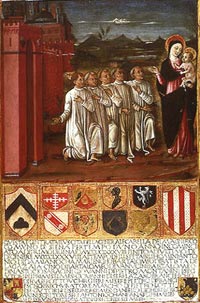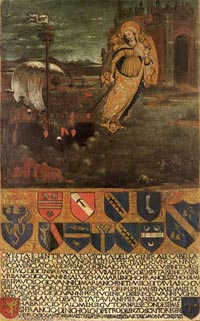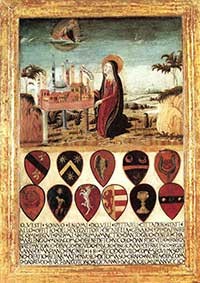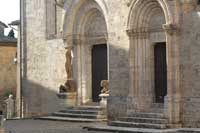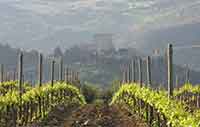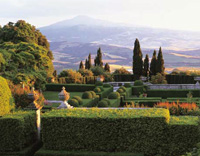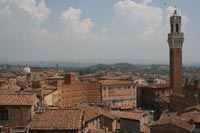In the second half of the quattrocento artists, destined to noticeably change the figurative culture through the more “modern” forms of the Renaissance, emerge in Siena: in Sculpture Donatello’s presence is very important; he is the artist who clearly caused the emergence of individual masters such as Vecchietta, Francesco di Giorgio, Giovanni di Stefano, Giacomo Cozzarelli. |
Fraiar Ugo, Camarlingo, frair of san galgano, made by Giulio di Pietro in 1258, is the oldest Biccherna. The first wooden boards are simple and have no intention of being masterpieces. Subsequently, however, the paintings become more elaborate and rich and are commissioned to famous authors as Giovanni di Paolo, Sano di Pietro, Lorenzo di Pietro called il Vecchietta. The layout of the boards remains, however, unchanged: at the top there is the painting and at the bottom the inscription bearing the date, the names of the main components of Biccherna, the arms of their families. By the mid-fifteenth century, then, the covers of records were no longer painted but real paintings were commissioned to hang on the walls of the office when the Camarlingo and the Provveditori left definitively their assignment. The subjects of the scenes represent leading events of the town, religious themes, episodes of contemporary politics. |
||||
Diotisalve di Speme, The arms of the four Provveditori, 1263 |
||||
Many of Sienese Biccherna Covers have Our Lady as common subject. This is not so strange, the history of Siena is full of events which show the particular devotion of the Sienese to Our Lady.
See for example how nice is the follow board which represents Our Lady in the act of protecting Siena by earthquakes, made by Francesco di Giorgio Martini in 1467 |
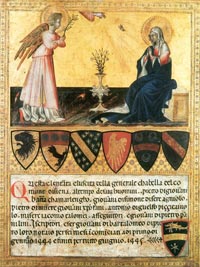 Giovanni di Paolo, L'Annunciation, 1445, Vatican |
|||
Francesco di Giorgio Martini (1439-1501), who emerges as the key to much of later Quattrocento art, was an Italian painter of the Sienese School and a sculptor, as well as being, in Nikolaus Pevsner's terms, "one of the most interesting later Quattrocento architects'" and a visionary architectural theorist. As a military engineer he executed architectural designs and sculptural projects and built almost seventy fortifications for the Federico da Montefeltro, Count of Urbino, for whom he was working in the 1460s, building city walls as at Iesi and early examples of star-shaped fortifications. Born in Siena, he apprenticed as a painter with Vecchietta. His earliest dated works are manuscript illuminations. Mournful eyes, a halting linear flow in drapery and hair, delicately awkward posing of necks and hands, and classically inspired architecture characterize his style. More sophisticated than his paintings, Francesco's sculpture shows acquaintance with earlier Florentine masters such as Donatello and Lorenzo Ghiberti, along with his contemporary Antonio del Pollaiuolo. By the 1480s Francesco was among Italy's leading architects. Working in Urbino for Federigo da Montefeltro by 1477, Francesco served as a diplomat, sculpted bronze reliefs, built 136 military fortresses, and probably completed the ducal palace. Francesco authored the first important Western writings on military engineering, works keenly studied by Leonardo and others. Francesco di Giorgio finished his career as architect in charge of the works at the Duomo di Siena, where his bronze angels are on the high altar and some marble floor mosaics are attributed to his designs. The typical tablet from the Biccherna (revenue office) has a votive subject: the Virgin as intercessor to protect the city against earthquake. The contribution of an anonymous assistant referred to as "Fiduciario de Francesco" is assumed. Art in Tuscany | Francesco di Giorgio Martini |
||||
| The Siena Cathedral was dedicated to the Virgin Mary from at least the tenth century; the thirteenth-century Cathedral was dedicated specifically to the Assunta (the Virgin Assumed). Not only is the Cathedral dedicated to the Virgin: the entire city is dedicated to her as well. Siena took Mary as its patron and ruler by the middle of the thirteenth century. This relationship is movingly evoked by a chronicle — apparently written by Paolo di Tommaso Montauri — that records the Battle of Montaperti (1260) fought by the Sienese and Florentines. On the eve of the battle, the sindaco (mayor) of Siena, a citizen named Buonaguida, processed to the Cathedral with a band of townspeople behind him. Arriving at the Cathedral, the bishop led Buonaguida to the altar of the Virgin Mary, where he prostrated himself and vowed that should the Virgin protect the Sienese, he would dedicate the city to her. Indeed, the Sienese were victorious the following day despite unfavorable odds, a miracle of such importance to them that they have preserved relics of the battle to this day. The Sienese took their fidelity to the Virgin seriously. In 1483, they renewed their vow to the Virgin following a period of submission to the Visconti of Milan. The declaration is vividly depicted on one of the Commune's painted record-books. The image shows the city magistrates handing the keys of Siena to the thaumaturgic icon of the Madonna of Thanks in the Cathedral. [2] From early in the thirteenth century it became customary to decorate with designs and paintings the wooden covers of the volumes in which accounts were kept. Many of these covers have been preserved and are highly prized, both for their artistic value and for the intimate glimpses they afford of Sienese life. The 1483 cover, titled L'unione delle classi e l'offerta delle chiavi della città alla Virgine is important also because testifies the original location of the Maestà made by Duccio di Buoninsegna in 1311 in the Cathedral, that is to say, in the altar. Nowadays you can see this masterpiece at the Museo dell'Opera Metropolitana. Art in Tuscany | Sienese Biccherna Covers | Biccherne Senesi |
||||
Two men stand behind the desk in the Biccherna office in Siena; the Camerlingo in red receives the taxes paid by the three men in the foreground while his colleague records the transaction. Above them is the Balazana or coat of arms of the city of Siena, beneath them are six coat of arms and below, a long inscription on a white ground. This Biccherna panel, so named after the chief financial office of Siena, was initially created as a cover for official documents dating to 1402 when Siena was under the domination of Gian Galeazzo Visconti duke of Milan. Previously catalogued as by an unknown painter, it was recognized as being associated with the workshop of Paolo di Giovanni Fei in 2002. Fei (c. 1344–1411) was one of the leading Sienese painters of his time and held several prestigious civic offices. Between 1395-1410 he was working at Siena Cathedral. Works such as the Birth of the Virgin (Siena, Pin. N.) and the Assumption of the Virgin (Washington, DC, N.G.A.) reveal his indebtedness to the Lorenzetti brothers, Bartolo di Fredi and to Simone Martini. Fei delighted in colour and incidental detail rather than rational spatial illusionism. The scene at the top of 414-1892 takes place in the office of the Biccherna, located on the ground floor of the Sienese Palazzo Pubblico. The camarlingo behind the counter at right, and the scrivener at left process the finances of the three men opposite them. Three strongboxes are visible on the counter, bench and floor. At the top centre is the balzana or heraldic crest of Siena and below the scene are six escutcheons of the families involved with this biccherna.The documents once protected by the V&A’s book cover are now lost, but similar parchment sheets can be seen in the State Archive in Siena. The manuscript leaves preceding the account papers within the tavolette were beautifully illuminated with elaborate initials and borders.[3] |
||||
Dietisalvi di Speme worked in Siena between 1250 to 1291. His work influenced Cimabue. Some of his work is preserved in the State Archives in Siena. His Madonna and Child with Angels is in the Pinacoteca di Siena. He collaborated with Guido da Siena. |
||||
This panel was painted in 1343 as the cover of an account book of the Biccherna, the financial administrators of the commune of Siena. The Biccherna was a committee of five individuals, four provveditori (purveyors) and one camarlingo (secretary), who served for six months. Two account books were issued each year. Most earlier examples show only the camarlingo, who between 1275 and 1349 was almost always a monk, often from the Cistercian abbey of San Galgano.
This example shows the camarlingo at left, in the white robes of a Cistercian monk, the clerk in the center, writing in a book, and one of the four provveditori at right. The arms of the provveditori were represented at the top of the panel, but are now indecipherable. |
Italian (Sienese) Painter, Tempera on wood,
Metropolitan Museum of Art, New York, dated 1343
|
|||
The Gabella tablet shows the gains of the town in time of peace and the losses occurred during wartime. It was painted after pope Pius II negotiated the peace between Bartolomeo Colleoni and Pietro dei Medici in 1468. |
||||
Lippo Vanni (Lippo di Vanni) was an Italian painter and illuminator. He is documented as a painter and illuminator in Siena between 1344 and 1375, and in 1360 and 1373 he took part in the General Council of Siena. The earliest work attributed to him is the illumination of the choirbooks for the Collegiata at San Gimignano (c. 1340-42, San Gimignano, Museo Arte Sacra), in which the supple movement and individuality of figures and scenes already show the expressive quality characteristic of Lippo's later documented work. Lippo Vanni, in 1352, frescoed a large Coronation of the Virgin in the office of the Biccherna. The history of ownership is not definitive or comprehensive, as it is under constant review and revision by MFA curators and researchers. Art in Tuscany | Lippo Vanni |
||||
On the cover of the ledger of the Gabella is celebrated the allegory of the good virtues; here the integrity of the public officials represents the foundation of the good government. Art in Tuscany | Benvenuto di Giovanni Art in Tuscany | Sienese Biccherna Covers | Biccherne Senesi |
||||
Guidoccio Cozzarelli |
||||
The Camerlingo and the Gabella’s Officials dressed in repentant robes ask the Virgin to enter Siena
The panel represents the officials of the Gabella office imploring the Virgin to enter Siena to protect it because of the political instability. Traditionally attributed to Guidoccio Cozzarelli is presented at the National Gallery exhibition in London as a work of Guidoccio’s master Matteo di Giovanni. |
||||
Guidoccio Cozzarelli The Virgin guiding “the ship of the Republic” tempera on panel, 54x36.2 cm (1487) Siena - ARCHIVIO DI STATO, MUSEO DELLE TAVOLETTE DI BICCHERNA The panel refers to the return to Siena of the magistracy of the Nine lead by Pandolfo Petrucci, who later became Siena’s ruler, as a welcome change occurred under the Virgin’s protection. Traditionally attributed to Guidoccio Cozzarelli it is presented at the National Gallery exhibition in London as a work of Guidoccio’s master Matteo di Giovanni. |
||||
| |
|
|
||
| Biccherna no 62, Guidoccio Cozzarelli (attr.), La presa di potere di Pandolfo Petrucci a Siena (Il ritorno dei Noveschi a Siena), 1488 ca., Archivio di Stato di Siena | Archivio di Stato di Siena, collezione delle tavolette di Biccherna, n. 89, Guidoccio Cozzarelli (?), “La Maddalena e la Lupa senese”, 1497
|
Gabella 47, Guidoccio Cozzarelli (attr.), Le stimmate di Santa Caterina, 1498 ca., Archivio di Stato di Siena
|
||
Neroccio di Bartolomeo de' Landi (Siena, giugno 1447 – Siena, 1500) è stato un pittore e scultore italiano del primo Rinascimento a Siena. In età giovanile allievo del Vecchietta, successivamente entrò nella bottega di Francesco di Giorgio dal 1468. |
||||
Photogallery Archivio di Stato | Palazzo Piccolomini
|
||||
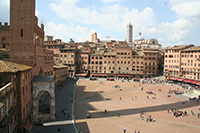 |
 |
 |
||
| Vista meravigliosa dall Archivio di Stato sulla Torre del Mangia e su parte della piazza del Campo | Palazzo Piccolomini, Siena, stemma Piccolomini (Banchi di Sotto, Siena)
|
The Sienese demolish the fortress of the Spanish, Giorgio Di Giovanni, 1552, Siena, Archivio di Stato, Museo delle Tavolette di Biccherne
|
||
 |
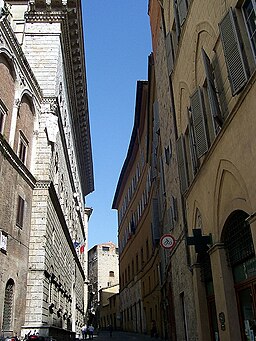 |
 |
||
Palazzo Piccolomini, Siena, ferri con crescenti (Banchi di Sotto, Siena)
|
||||
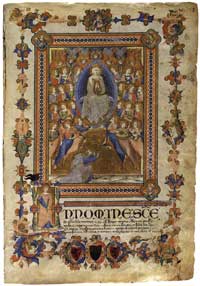 |
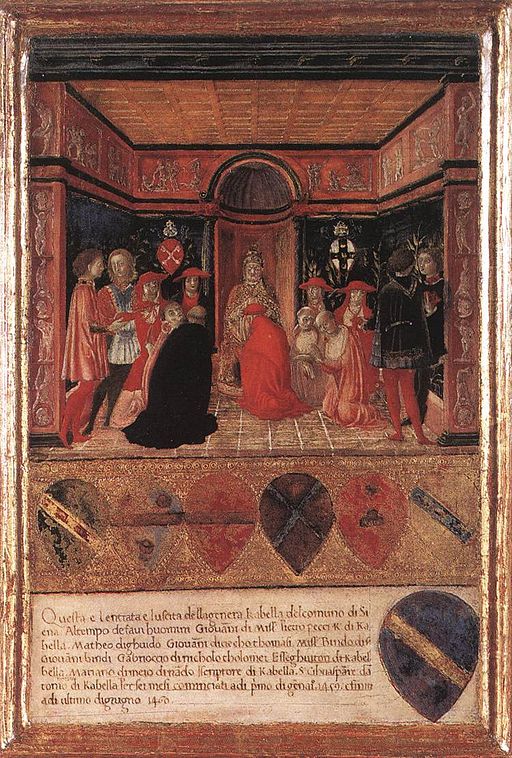 |
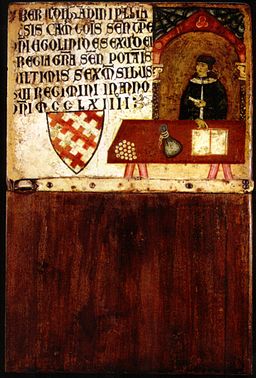 |
||
| Il Caleffo dell'Assunta" di Niccolò di Ser Sozzo, capolavoro della miniatura gotica, Archivio di Stato di Siena | Francesco di Giorgio Martini (1439–1501), Pio II impone il cappello cardinalizio al nipote Francesco Piccolomini Todeschini | Dietisalvi di speme, Tavoletta di biccherna del camarlengo Ildebrandino Pagliaresi | ||
(Lightbown 1963, pp. II-III). [2] Andrea Campbell, A spectacular celebration of the Assumption in Siena, Renaissance Quarterly, June 22, 2005 |
| Painters of Sienese Biccherna Covers
* Dietisalvi di Speme, qui en aurait peint 56 dont il en reste seulement quatre (vers 1270). |
Siena | Archivio di Stato di Siena Tuscany | Siena Surroundings Art in Tuscany | Sienese School of Painting Museum of the Biccherna Tablets in Siena. In Palazzo Piccolomini, typical style of Florentine Renaissance, this museum holds the ancient tablets of the state ledgers and a collection of ancient manuscripts and books. The Biccherna panels offer a history of Sienese art in miniature, over the course of which you can watch the Byzantine formality yield to a Gothic sense of realism, then supplanted by Renaissance one-point perspective, and so on. The panels also offer crucial historical information, showing the monks and nobles who served as tax officers. Archivio di Stato di Siena | Collezione delle Tavolette di Biccherna e Mostra documentaria | www.archiviostato.si.it (it) The Museum is located in Via Banchi di Sopra # 52 and it is open from Monday to Saturday at 9.30 - 10.30 and 11.30 Free entrance. www.arteantica.eu | Biccherne Senesi |
Pienza |
Podere Santa Pia, view from the garden on the valley below |
San Quirico d'Orcia |
||
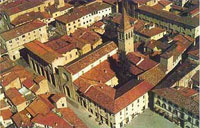 |
||||
| Wine regions | Podere Santa Pia |
Sansepolcro |
||
Villa La Foce In the background Monte Amiata |
Siena, duomo |
Siena, Piazza del Campo |
||
Siena is reknowned, both nationally and internationally, for the Palio horse race contested by the 17 contrada which divide this small city. But Siena is also unique thanks to its maze of narrow streets, its numerous towers and elegant town houses, the immense Piazza del Campo and the Cathedral which dominate the heart of the Medieval city encircled by impressive walls. As far as culture is concerned, Siena has been a city of great artistic significance since ancient times with internationally acclaimed institutions such as the Chigiana Musical Academy, the Accademia dei Fisiocritici and Accademia degli Intronati, as well as the University for Foreigners. Sites not to be missed are the Church of St Domenico, the Church of St Francesco, the Diocesan Museum of Sacred Art and Palazzo Salimbeni which houses important frescoes. Villa La Foce in Chianciano Terme In 1927, Marquis Origo and his wife Iris bought Villa La Foce, which in origin was a hostelry. The two benefactors had the area reclaimed and commissioned the construction of a kindergarten, of a school and of a surgery in the neighbourhood. The garden surrounding the building is the outstanding element of the whole estate: it was designed by Cecil Pinsent, a landscape architect who at the beginning of the 20th century projected the parks of the most important Florentine residences. Divided into various sectors following the trend of the land, the garden was realised in different phases, from 1927 to 1939, and features a lemon garden, a rosary and a sector decorated with box and laurel hedges, in which a fountain is to be admired. The realisation of the last part of the garden began in 1938. Here there are the so-called "Grotta azzurra" (the azure grotto), decorated with seven niches, and a statue representing Nature bearing the fruits of the land. |
||||

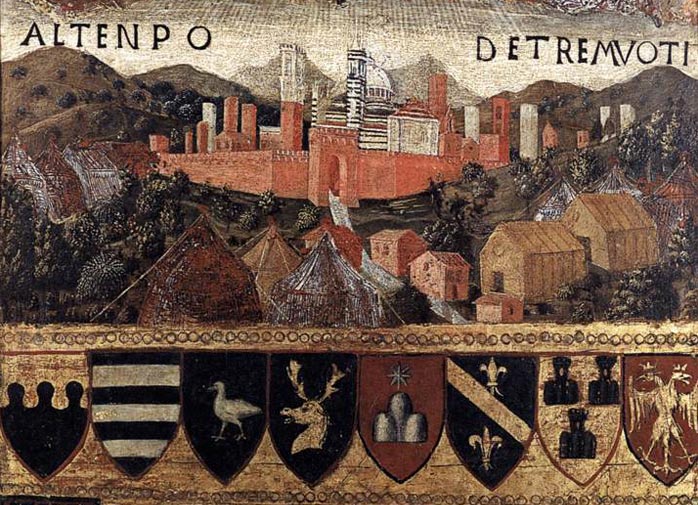
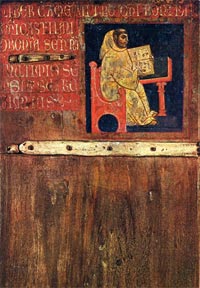
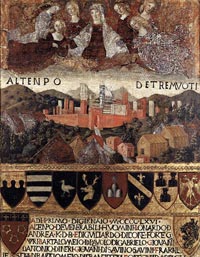
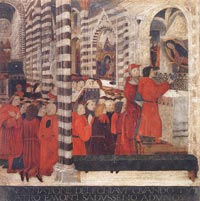
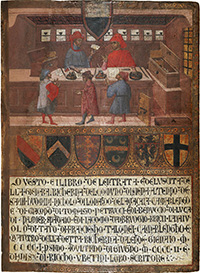
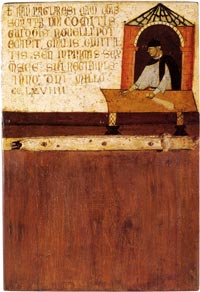
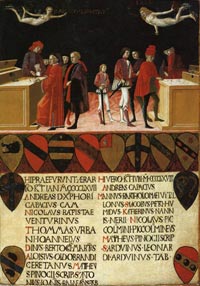
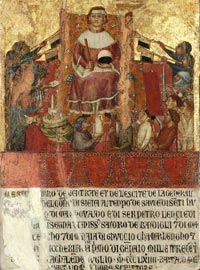
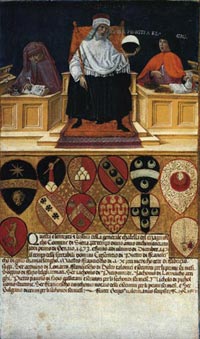 Benvenuto di Giovanni
Benvenuto di Giovanni